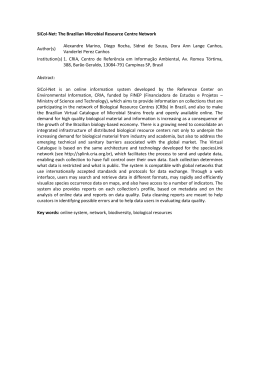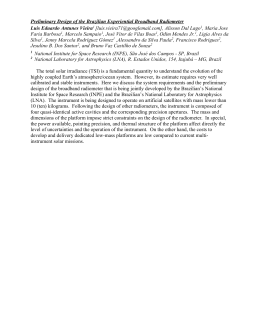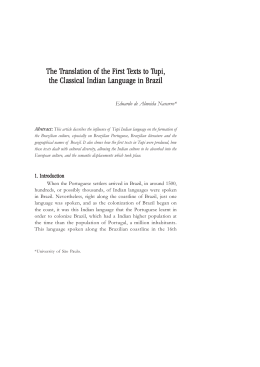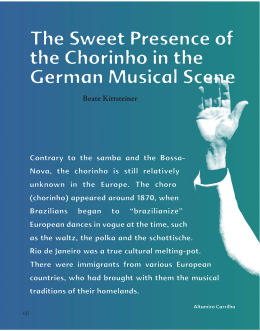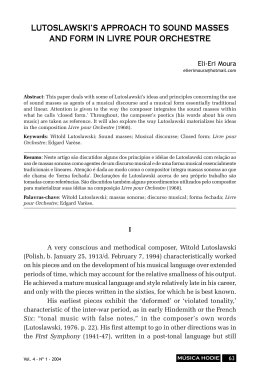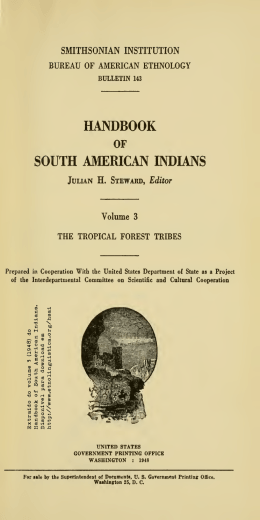FROM THE KINGS OF THE RADIO TO THE “BOQUINHA DA GARRAFA” Tom Tavares When the first official radio transmission took place in Brazil, eighty loudspeakers spread around the old federal capital broadcast the speech of the President of the Republic, Epitácio Pessoa, in his last year of government. After the sound of power, it was the turn of the power of sound: the overture of the opera "O Guarani", by composer Antonio Carlos Gomes, was broadcast directly from the Municipal Theater of Rio de Janeiro. Carmen Miranda 71 72 ll this happened on the 7th of September, 1922, at the celebration of the one hundredth anniversary of independence. In one hundred years, the federation had been through successive political crises, distinguished by a fragile economy, already indebted to England, as a transfer from anachronistic royalty to the royal farce of a new republic that proved old early on. When that September arrived, in spite of the immoderacies A Theater, side by side with the already famous Vicente Celestino; and Ernesto Nazareth enjoyed the success of compositions like “Brejeiro”,“Odeon” and “Apanhei-te Cavaquinho”. There was more: in São Paulo, Zequinha de Abreu made couples dance to the sound of “Tico-Tico no Farelo”, later turned into the world famous “Tico-Tico no Fubá”. More to the south, in Porto Alegre, Radamés Gnattali played the piano in the Cine Columbus, producing his first practiced by the leaders of the country, it was also a time to tally some good reasons for hope and optimism. One of the reasons was the musical production. We had a good sound legacy from the flute of Joaquim Antonio da Silva Calado and we still had the piano of Chiquinha Gonzaga. I t was twenty years before the first recording of Brazilian popular music (“Isto É Bom”, by Xisto Bahia, cut by Casa Edison) and seven months after the “ Week of Modern Art”, an event in which Brazilian music was represented by Ernani Braga, Fructuoso Vianna and Heitor Villa-Lobos. In the early 1930’s, Brazil was already “artful”. Some of the most important artists of our history appeared at that time: Pixinguinha toured France and recorded at RCA-Vitor, Argentina, with the “Oito Batutas”; on the mandolin, Luperce Miranda integrated the Jazz Leão do Norte, in Recife; the sound of the piano of Ari Barroso filled the foyer of the Iris Cinema, at Largo do Carioca; Josué de Barros returned to Brazil after making the first Brazilian music recordings in Europe; Francisco Alves made his debut in the São José scores with distinctly Brazilian musical elements. Thus, when Roquette Pinto inaugurated our first broadcasting station, Radio Sociedade, on the 20th of April, 1923, the collection of compositions developed in Brazil was already vast and varied enough to meet the demand of the audience reached by the new communication medium. The deficiency was not, therefore, in the field of creation. It was in the area of recording, since the existing studios did not yet have the best technical resources for capturing and reproducing sound. The 78 rpm records did not offer fidelity, neither did the microphones, nor the transmitters and much less the rare receivers. But they would do. The radio became popular. The radio age had begun. New radio stations were quickly created and involved in a healthy competition for audience through quality. Not only for the capacity of the producers and presenters. The men of radio back then, perhaps due to lack of better options, structured the whole program based on music. Luckily, thanks Photo: Mario Thompson Photo: Prensa 3 Sílvio Caldas to their competence, the music was good. Thus a relationship was established where all interests were met: the record company had its work divulged; the artist, broadcast by the radio station, expanded his field of action; and the radio station, in development, devoid of material to fill its program, fed on the rich and varied musical vein. It is true that the Rádio Jornal do Brasil distinguished classical music. But it is also true that the other radio stations never tired of broadcasting the best of our new music of those days . The new music of Pixinguinha, Noel Rosa, Lamartine Babo, Mário Reis, Ari Barroso, Carmen Miranda, Silvio Caldas, Donga. New music full of new rhythms, of lundú, maxixe, choro, march, samba, that, thanks to the inexorability of time, would soon integrate the repertoire of what was called “old guard”. Complementing the sound collection from the record companies, radio stations in the 20’s started to broadcast live music, played right there in the transmission studios. Once again, this proves the quality of the Nelson Gonçalves artists of that period: only the really competent can play live. So competence there was. With the creation of Radio Nacional, in 1936, the audience started to compete for a place to see the radio programs. That’s right, to see the radio. The live auditorium programs arrived, dividing their time between presentations of musicians, famous singers and also new ones, called “calouros”, which increased the already extensive list of musical attractions. At that time, the radio went through its first transition. Little by little, announcers lost the command of the programs, now exercised by exclusively hired singers and composers. Rádio Mayrink Veiga had Carlos Galhardo and Silvio Caldas; Tupi bet on Dircinha Batista; Rádio Educadora presented the “Horas Lamartinescas”; the presence of Alimirante was unmistakable in Tamoio; Ari Barroso shone in Cruzeiro do Sul. Rádio Nacional, in turn, had a heavyweight team on the air, in which the highlights were Francisco Alves, Linda Batista, Nuno Rolando, Manezinho Araújo, 73 Nelson Gonçalves and Orlando Silva. Absolute audience leader in the 40’s and 50’s, Nacional had, under contract, 15 conductors, as well as two regional groups and a great orchestra made up of 144 members. It also employed soloists of the caliber of Jacob do Bandolim, Abel Ferreira, Luperce Miranda, Luiz Americano, Dilermando Reis, Garoto and Chiquinho do Acordeon. Not satisfied with that, it overturned our presidential regime by crowning Marlene, Dalva de Oliveira, Emilinha Borba, Ângela Maria and Dóris Monteiro, the Queens of the Radio, golden voices in the sound tracks of the romantic years of the first half of the twentieth century. From 1950, the competition for audience incr eased even more with the dawn of television in Brazil. The most important television stations implanted at that stage were Tupi, Nacional, Rio, Paulista, Continental, Excelsior, and Record. This new communication medium conquered Brazilian homes using as attractions the same great radio names. Although the programs were truly diversified, with soaps, news, films, the leadership of the musical programs was undeniable. So television was also born, learned to walk, and grew on a foundation of Brazilian music: not only the effective one but also the music resulting from the new movements that rocked the country between the fifties and the sixties: Bossa Nova, Jovem Guarda and Tropicalismo. There was room for all of them on the screen when the MPB Festivals (launched by TV Excelsior in 1965, imitated by Record and, later, TV Globo) selected the repertoire to be sung by the nation. Tom Jobim, 74 Vinícius de Morais, Baden Powell, Geraldo Vandré, Jair Rodrigues, Chico Buarque, MPB 4, Nara Leão, Wilson Simonal, Roberto Carlos, Edu Lobo, Elis Regina, Caetano Velloso, Gal Costa, Gilberto Gil, Os Mutantes, Tom Zé, Sérgio Ricardo, Dori Caymmi, Nelson Mota, Luiz Bonfá, Antonio Adolfo, Milton Nascimento, Guarabira, Paulinho da Viola, Marcos Valle, Sueli Costa, Ivan Lins, Beth Carvalho, Antonio Carlos and Jocafi, Gonzaguinha, Egberto Gismonti and Jorge Benjor were some of the great names that appeared at that time. The musical programs, such as “O Fino da Bossa” (TV Record),“Um Instante Maestro” (TV Tupi), “A Grande Chance” (TV Tupi),“Vamos S’imbora” (TV Record),“Esta Noite Se Improvisa” (TV Record),“Rio Hit Parade” (TV Rio) dominated the prime time. Young people could choose from “Todos os Jovens do Mundo” (TV Record),“Os Brotos Comandam” (TV Continental), “Festa do Bolinha” (TV Rio),“Jovem Guarda” (TV Record),“Jovem Urgente” (TV Cultura), “Poder Jovem” (TV Tupi),“Brasa 4” (TV Itacolomi-BH), and others. This ebullience continued way into the seventies, leaving the scene when Paulista, Tupi, Excelsior and Continental television stations were swallowed by the big networks, whose paradigm is TV Globo. The process of dismantlement obviously included the dismissal of regional groups, whole orchestras, conductors, in short, all the musical heads that did not surrender to the dictates of the newest Gilberto Gil Photo: Prensa 3 Donga even sabotaging, the free development of artistic thought, squeezing everything and everyone, all wrapped in the same package, through the mouth of the bottle. Tom Tavares – Composer and Conductor, Professor of the School of Music of the Federal University of Bahia . Photo: Mario Thompson art director of the TV stations: the market. For the vacancies left by the radio kings and queens, the media owners elected their ideal stars: luminous kings of submission, of subservience, ideologically barren lambs. It was the end of a plural and culturally successful relationship between the industries of music and communication. From then on, the big networks imposed their will like great looting armies, frontally disregarding the legislation that allows their operation. The radio and TV stations practically dumped the law of concessions, teaming up with entrepreneurs whose musical sensitivity is restricted to the allure of tingling coins. It seems like fiction, but regrettably it is the truth. There was a time when music, projected through loudspeakers, identified, in the conical format of this accessory, one of its symbols. It was the representative outline of growth, evolution, expansion, freedom. Today, the media refuses to contemplate diversity, discouraging, 75
Download



